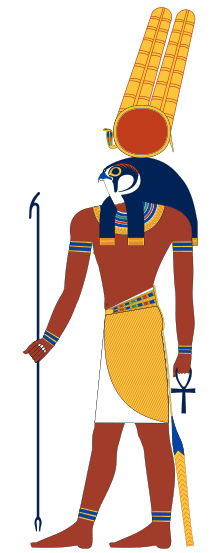Montu
| Monthu or Menthu | ||||
|---|---|---|---|---|
| God of warfare, the sun and valor | ||||
 the Egyptian war-god Montu. He was usually depicted as a falcon-headed man with two plumes and a sun disk. He was also said to have the head of a bull when enraged. | ||||
| Name in hieroglyphs |
| |||
| Major cult center | Hermonthis, Thebes | |||
| Symbol | the sun disk, the knife | |||
| Consort | Raet-Tawy, Tenenet, and Iunit | |||
Montu was a falcon-god of war in Ancient Egyptian religion. Montu's name, shown in Egyptian hieroglyphs to the right, is technically transcribed as mntw. Because of the difficulty in transcribing Egyptian, it is often realized as Mont, Monthu, Montju, or Menthu.
Montu was an ancient god, his name meaning nomad, originally a manifestation of the scorching effect of the sun, Ra, and as such often appeared under the epithet Montu-Ra. The destructiveness of this characteristic led to him gaining characteristics of a warrior, and eventually becoming a war-god.
Because of the association of raging bulls with strength and war, Montu was also said to manifest himself in a white bull with a black face, which was referred to as the Bakha. Egypt's greatest general-kings called themselves Mighty Bulls, the sons of Montu. In the famous narrative of the Battle of Kadesh, Ramesses II was said to have seen the enemy and "raged at them like Montu, Lord of Thebes".

In Ancient Egyptian art, he was pictured as a falcon-headed or bull-headed man who wore the sun-disc, with two plumes on his head, the falcon representing the sky, and the bull representing strength and war. He would hold various weaponry, including scimitars, bows and arrows, and knives in his hands.
The Temple of Montu at Medamud was probably begun during the Old Kingdom era. Temples to Montu include one located adjacent to the Middle Kingdom fortress of Uronarti below the Second Cataract of the Nile, dating to the nineteenth century BCE. During the New Kingdom, large and impressive temples to Montu were constructed in Armant. In fact, the Greek name of the city of Armant was Hermonthis, meaning the land of Montu.
Montu had several consorts, including the goddess Tenenet, the goddess Iunit, and a female form of Ra, Raettawy.[1]
Mentuhotep, a name given to several pharaohs in the Middle Kingdom, means "Montu is satisfied".
References
- ↑ Wilkinson, Richard H. (2003). The Complete Gods and Goddesses of Ancient Egypt. Thames & Hudson. pp. 150, 203